PUNE
Markets
Last updated on 18 July 2025. Help us improve the information on this page by clicking on suggest edits or writing to us.
Mahatma Phule Mandai
Mahatma Phule Mandai, located in the heart of Pune, is the city’s largest and most iconic retail market for fruits and vegetables. Established in 1885, the market is known not only for its daily bustle but also for its architectural and cultural legacy. Originally named after Lord Reay, then Governor of Bombay, the structure was later renamed in memory of Mahatma Jyotirao Phule, an influential social reformer who had opposed its construction due to the heavy civic cost involved. Many local leaders of the time, including Bal Gangadhar Tilak, voiced concerns over the expense.
Built under British supervision, the Mandai is a striking example of Victorian Gothic architecture, featuring pointed arches, wooden roof structures, and an octagonal layout. The eight entrances and exits extend outward like petals, offering continuous facades along the adjoining streets. Each entry leads into a naturally lit and well-ventilated central space, allowing for an airy, pleasant market experience. The thoughtful spatial planning includes separate sections for fruit vendors in the northern lanes, vegetable sellers in the central rows, and onion and potato sellers in the southeastern part. Organized stalls and designated areas for farmers help reduce congestion and ensure smooth flow of visitors.
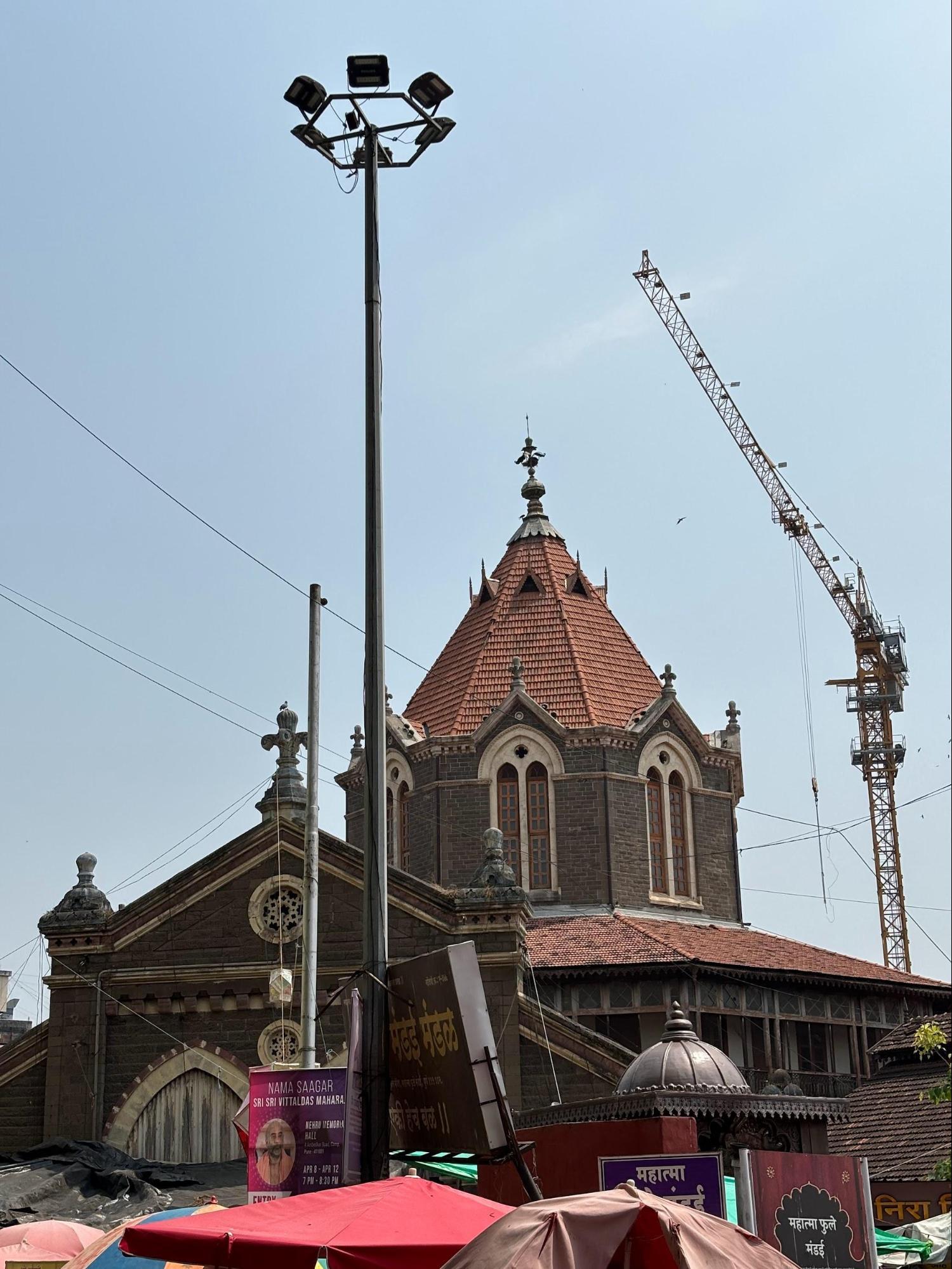
Presently, Mahatma Phule Mandai houses over 500 stalls, many of which are run by families who have been selling produce here for generations. The market remains crowded throughout the day, as it offers fresh fruits and vegetables at lower prices than most other areas in Pune. Customers are welcomed by the fragrance of flowers, spices, and traditional ingredients the moment they step inside. Plans are underway to beautify and redevelop the surroundings due to the construction of an underground metro station nearby.
Culturally, the Mandai holds special significance. It is home to one of Pune’s oldest Ganpati mandals, established in 1893. Since 2006, the market has also hosted Art Mandai, an annual art exhibition held in January, where fruit and vegetable vendors generously share their space with local artists who showcase handcrafted products and artwork, making it a vibrant intersection of commerce, tradition, and creativity.
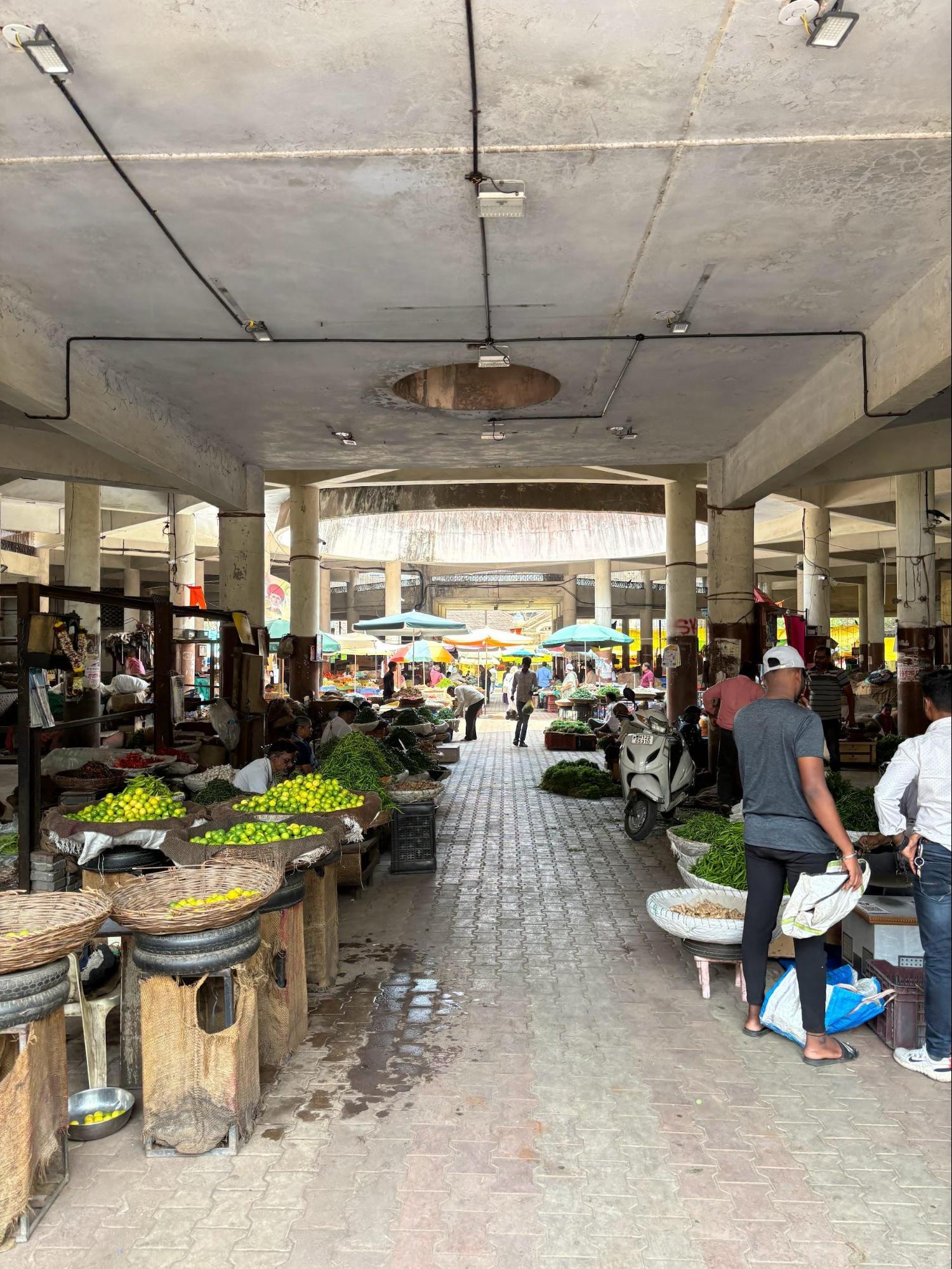
Market Yard
The wholesale market at Gultekdi, commonly known as ‘Market Yard’, is home to Pune’s Agricultural Produce Market Committee (APMC). Originally part of Mahatma Phule Mandai, the wholesale trade was shifted to this location in 1980 to decongest the older city markets in the Peth areas and streamline agricultural supply chains. Today, Market Yard includes over 1,800 shops, known as galas, where traders purchase produce directly from farmers. The produce sold here comes not only from nearby towns and villages but also from neighboring states such as Gujarat and Karnataka. Once bought in bulk, goods are transported into the city for retail sale.
Fruit-sellers at the market largely belong to communities like the Khaire, Banwari, Kachi, and Dhamdhere families, many of whom migrated to Pune around 1920. They began their businesses at Mahatma Phule Mandai before relocating to the current site in 1980. Earlier, produce prices were negotiated using a traditional system called hatha/hatta, where middlemen and retail traders would shake hands under a handkerchief, using hand signals to discreetly communicate and agree on rates.
Beyond the trading activity, Market Yard also houses essential facilities such as guesthouses for farmers, grievance redressal offices, canteens, first-aid centers, and giant weighing stations. The market supports the livelihoods of countless drivers, loaders, porters, and helpers, making it a crucial part of Pune’s food economy.
Hong Kong Lane
Hong Kong Lane, located off Deccan Gymkhana in Pune, traces its origins to 1961. After the devastating Panshet dam failure flooded parts of the city and destroyed several marketplaces, the Pune Municipal Corporation (PMC) allotted shop spaces in this narrow lane to affected vendors as part of the rehabilitation effort. Over time, more traders joined in, selling similar goods and transforming the lane into a thriving market.
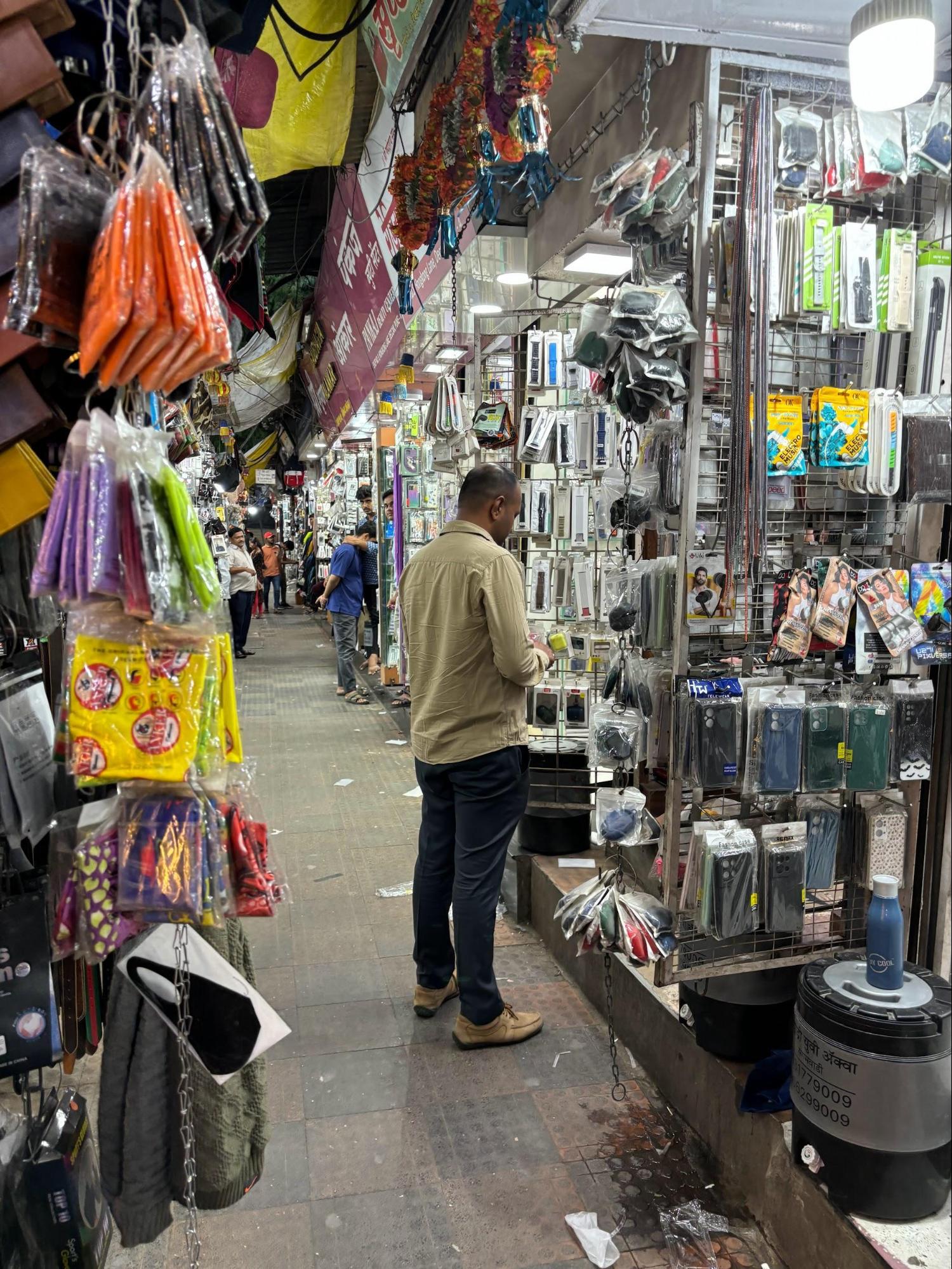
The lane is now known for its wide range of affordable products—including clothing, cosmetics, purses, jewelry, mobile accessories, and even books. Many of these items were originally imported from Hong Kong, which led to the market being popularly known as “Hong Kong Lane.”
Today, the marketplace is a bustling alleyway packed with shops offering everything from phone covers and chargers to repair services and textiles. Most of the shops are run by Rajasthani Marwari merchants and their extended families, many of whom have been in business in Pune for generations and operate stores in other parts of the city as well.
Fergusson College Road
Colloquially known as FC Road, Fergusson College Road is one of Pune’s most popular weekend shopping destinations. Stretching alongside the iconic Fergusson College, the road has gradually evolved into a vibrant street market lined with vendors, legacy eateries, and branded outlets.
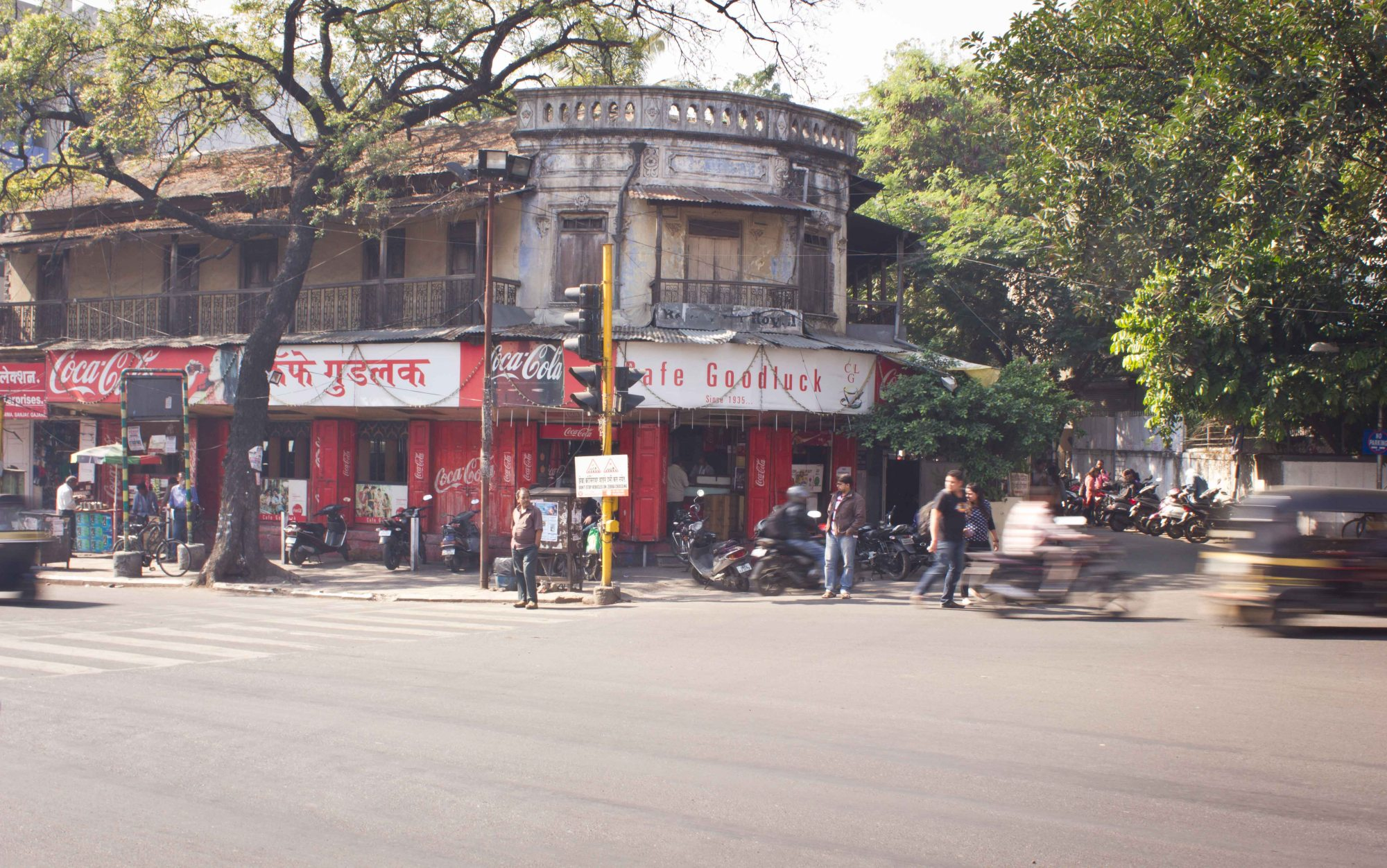
The market is best known for its affordable fashion including sunglasses, caps, rings, budget clothing, accessories, and gift items. Among its landmark eateries, Goodluck Café, established in 1935, remains one of Pune’s oldest Irani cafés, famous for its bun maska and bun omelette. Other local favorites include Vaishali and several fast-food counters that line the street. FC Road is also home to noteworthy stores. Venus Traders is a stationery haven stocked with art supplies, office goods, and school materials. For fitness enthusiasts, Champion Sports is a trusted outlet offering sportswear, equipment, whey protein, and other supplements.
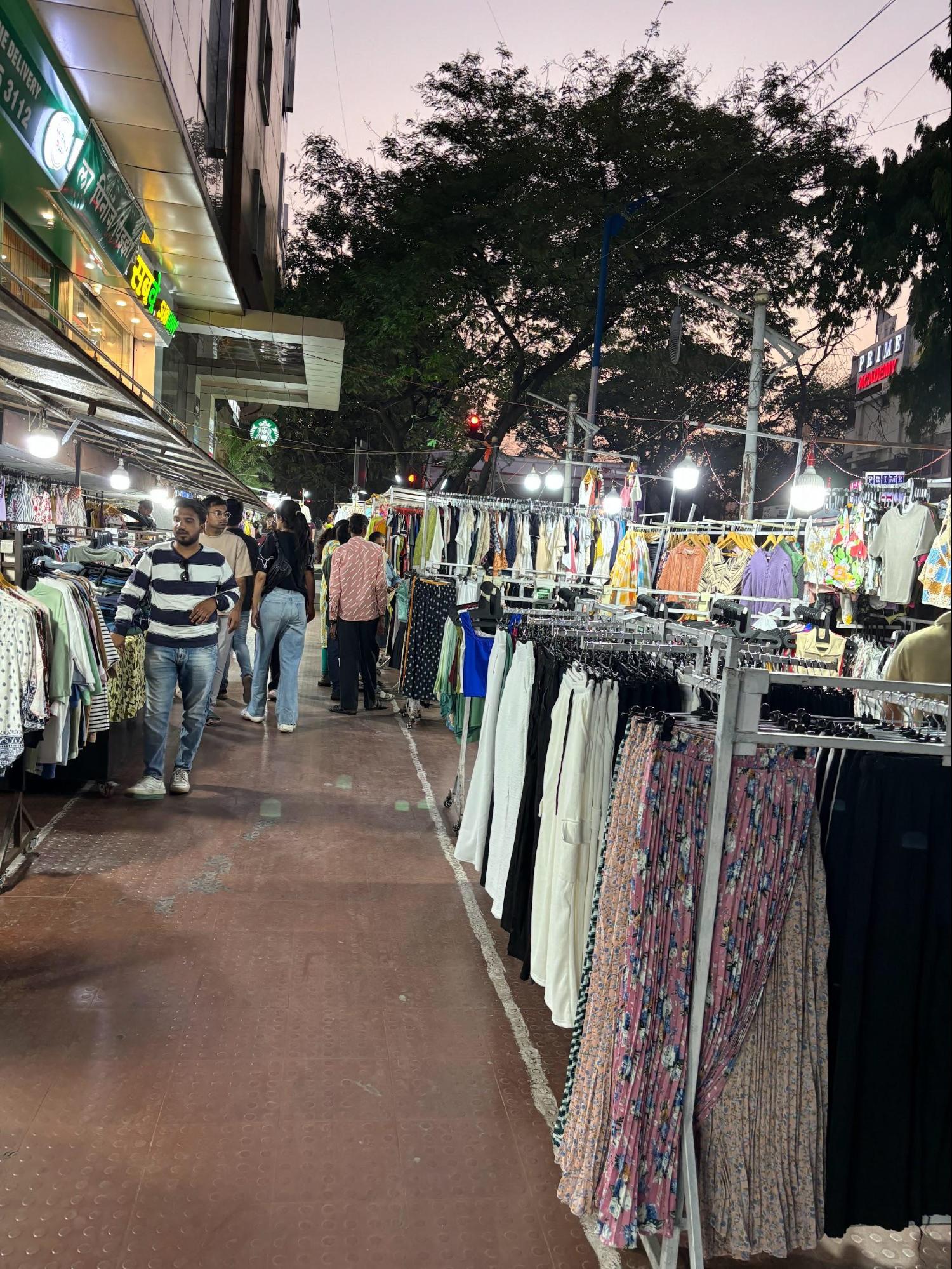
Street food is another major draw. Visitors can enjoy Davangere dosa near the Westside store, or try stalls offering Dabeli, Paratha, Momos, sweet corn, paan, and refreshing soda. Small food carts opposite Frozen Bottle are popular evening stops. The area buzzes with activity, especially in the evenings. A mix of college students, locals, and tourists flock here not just to shop, but to socialize, eat, and experience Pune’s youthful energy. Bargaining is common, and the street’s blend of affordability and atmosphere makes it a key retail and food hub in the city.
Juna Bazaar
Juna Bazaar, literally meaning "old market", is one of Pune’s oldest and most iconic flea markets, with a history dating back over 250 years. Located near the Mula River, it comes alive every Wednesday and Sunday between 8:30 am and 5:30 pm, when vendors set up and later dismantle their temporary stalls by evening. The market is primarily run by traders from nearby areas like Mangalwar Peth, Somwar Peth, Nana Peth, and Rasta Peth, many of whom have been in the business for generations. It is known for its eclectic mix of antiques, vintage collectibles, brass furnishings, household tools, jewelry boxes, vinyl records, Hibachi-style grills, and old clocks. Some items sold here are decades old, while others are repurposed or upcycled goods.
![Temporary stalls at Juna Bazaar, Pune’s 250-year-old market known for antiques, vintage items, and second-hand goods.[1]](/media/culture/images/maharashtra/pune/markets/temporary-stalls-at-juna-bazaar-punes-250-year-o_QVJlQIi.png)
Juna Bazaar attracts tourists, filmmakers, and collectors alike, often in search of rare or historically significant finds. It is said that many artifacts now housed in Pune’s Kelkar Museum were originally sourced from this very market by the museum's founder, Dinkar Kelkar. Beyond commerce, Juna Bazaar is about continuity—families who have traded here for generations continue to do so, maintaining a sense of heritage while adapting to changing times. For those seeking nostalgia, bargains, or unique pieces, it remains a cultural landmark in Pune’s marketscape.
Kumbharwada
Kumbharwada is Pune’s traditional pottery market, located across from Juna Bazaar near the banks of the Mutha River. The area traces its origins to the Nizam Shahi period, when nearby hamlets like Kumbhari, Kasari, and Punewadi were merged to form Kasba Pune, a fortified settlement with three main gates. One of these gates, located by the river, came to be known as Kumbhar Ves, named after the Kumbhar or Kumbhakar (potter) community that settled there due to the easy availability of space and water for pottery-making.
![A vendor at Kumbharwada, Pune’s historic pottery market, surrounded by earthen pots, lamps, and clay items.[2]](/media/culture/images/maharashtra/pune/markets/a-vendor-at-kumbharwada-punes-historic-pottery-m_S56amQP.png)
Today, Kumbharwada remains a vibrant cluster of small shops and open stalls, where artisans sell earthen pots, diyas (lamps), lanterns, tabletop décor, miniature clay figurines, and other terracotta items. It is especially bustling during Diwali, when the demand for traditional clay lamps surges. Though modest in appearance, the market reflects a living craft tradition that continues to thrive in the urban landscape.
Appa Balvant Chowk (ABC)
Popularly known as ABC, Appa Balvant Chowk is one of Pune’s most well-known book markets, a one-stop destination for textbooks, storybooks, competitive exam guides, and stationery in multiple languages and for various educational boards and levels. The market is named after Appa Balwant Mehendale, a sardar in the court of Peshwa Sawai Madhavrao, and operates daily from 9:00 am to 9:00 pm, except on Mondays.
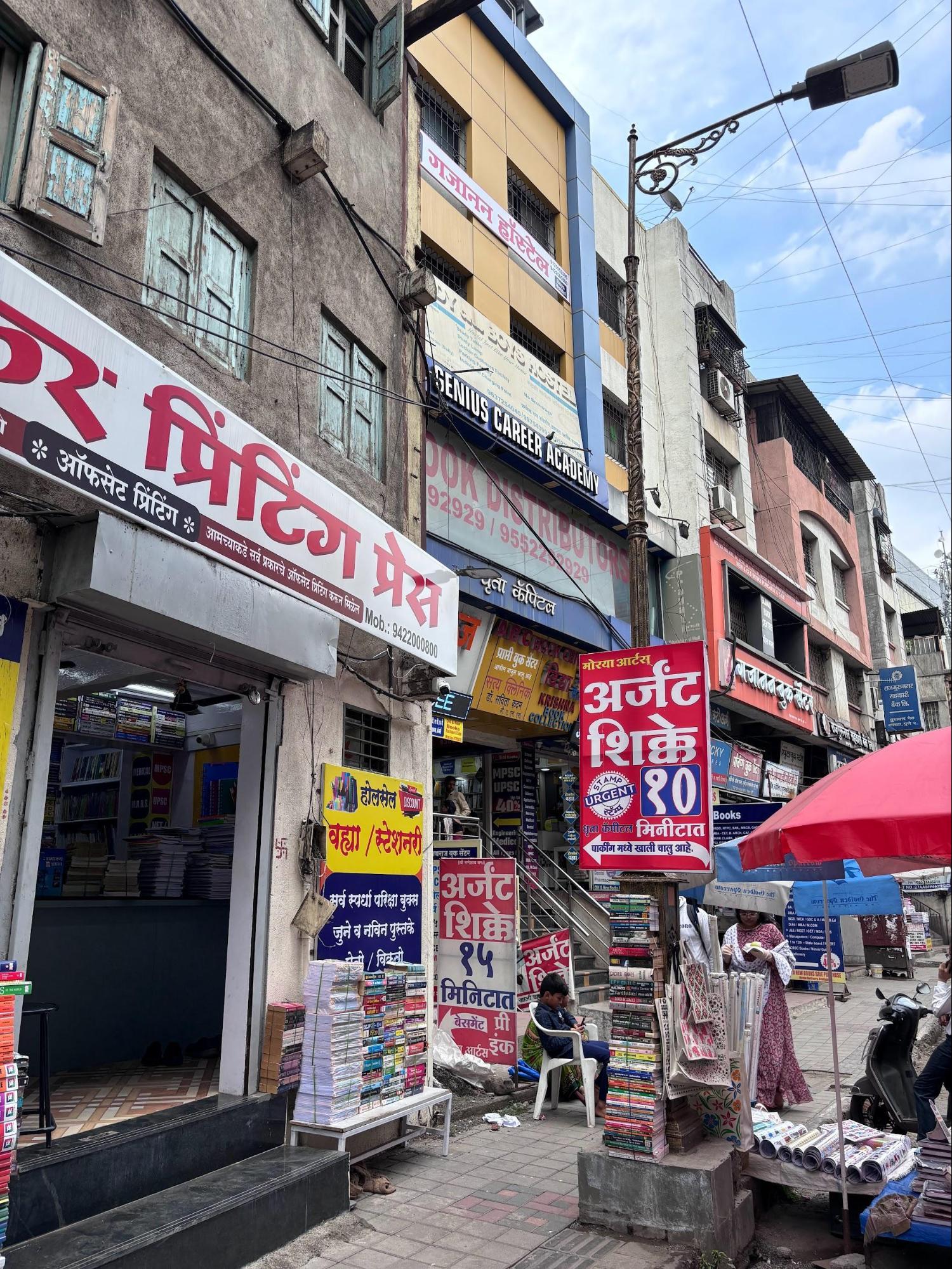
The area became a book hub when L.N. Godbole established the first bookshop here. Over time, others joined, setting up their stores in old wadas that gradually transformed into more functional, small-scale shops. Today, despite competition from online retailers, ABC remains a dependable place for students to find nearly any book or academic material they need.
Beyond its role as an academic marketplace, Appa Balvant Chowk has deep historical significance. During the Quit India Movement, on 9 August 1942, a teenager hoisted the Indian flag in defiance of British rule. In response, police opened fire, killing two people. This incident galvanized local resistance and ultimately led to the bombing of the Victory Theatre—an event remembered as a turning point in Pune's participation in the freedom struggle (see Stories chapter for details).
Also located on the main road is the Kibe Laxmi Theatre, established by Sardar Ramchandra Mukundrao Kibe in memory of his mother. The theatre is a notable local venue and draws regular crowds for its film screenings.
Clover Center
Located in the Camp area, Clover Center is a bustling shopping complex that houses over 500 small and medium-sized shops within a multi-storey building. Established in 1974, the center is believed to have been named as a symbol of good luck and innovation, with the "clover" referencing fortune and prosperity.
The market is popular for its wide range of affordable products, including clothing (such as kurtas, scarves, and menswear), costume jewelry, cosmetics, and lingerie. Known for its dense maze of shops and lively energy, Clover Center remains a go-to destination for budget-friendly shopping in Pune.
Laxmi Road
Laxmi Road is one of Pune’s most iconic shopping streets, known for its blend of traditional shops and modern retail complexes. Unlike more informal or weekly markets, Laxmi Road offers everything from small, modest stores selling daily wear and household items to multi-storey, air-conditioned complexes specializing in clothing, jewelry, and bridal shopping.
![Shoppers crowd Laxmi Road’s busy storefronts, Pune’s iconic destination, for sarees, jewelry, and festive shopping.[3]](/media/culture/images/maharashtra/pune/markets/shoppers-crowd-laxmi-roads-busy-storefronts-pune_xKDFkIJ.png)
Well-known for its extensive saree shops, the street is especially popular with brides-to-be. Stores such as Peshwai and Vama are famed for their Nauvari sarees and traditional Maharashtrian attire, while Gandhi Khadi Bhandar, established in 1942, continues to offer handwoven khadi fabrics. Several major jewelry brands have flagship showrooms here, reinforcing the road's reputation as a premium bridal and festive shopping destination.
There are multiple stories surrounding the origin of Laxmi Road. One theory attributes its growth to the gradual expansion of Peshwa-era markets, from Kasba Peth to Budhwar Peth (Tulsibaug) and eventually to Laxmi Road around 70 years ago. Another credits its planned development in 1912 to Diwan Bahadur Godbole, a prominent city resident. The name itself is also debated: some say it honors Devi Laxmi, goddess of prosperity, due to the commercial success of the street; others claim it was named after Laxmibai, the wife of Dagdusheth Halwai, who was a respected social worker.
Laxmi Road is especially vibrant during festivals like Diwali, Akshaya Tritiya, and Ganesh Chaturthi. On Dhanteras, the entire street is illuminated with decorative lights, celebrating prosperity and the blessings of the goddess it’s named after. The market remains closed on Mondays and is busiest during festival seasons and weddings.
Tulsi Baug
This is one of those markets in the city that grew and became popular because of a cultural site. The name ‘Tulsi Baug’ translates to a garden full of tulsi plants (holy basil), as the site itself was once a garden. There is also a Tulsi Baug wada located nearby.
In 1761, the Peshwas had finished building a Ram mandir complex with three mandirs. The main one in the middle being dedicated to Bhagwaan Ram and two smaller mandirs on either side dedicated to Bhagwaan Ganpati and Bhagwaan Mahadev. These mandirs have remained intact since their inaugural and its courtyard became a great spot for vendors to sit and sell their products. Over time, the stalls put up by the vendors expanded and became popular. Today, this courtyard has become a traditional and popular shopping center selling brass, copper utensils, pooja items and it looks like an old fashioned bazaar. Traditional items, kitchen appliances, cosmetics, toys, clothing, ornaments, footwear etc. are sold here and it is believed that some of these shops make a turnover of crores on a daily basis.
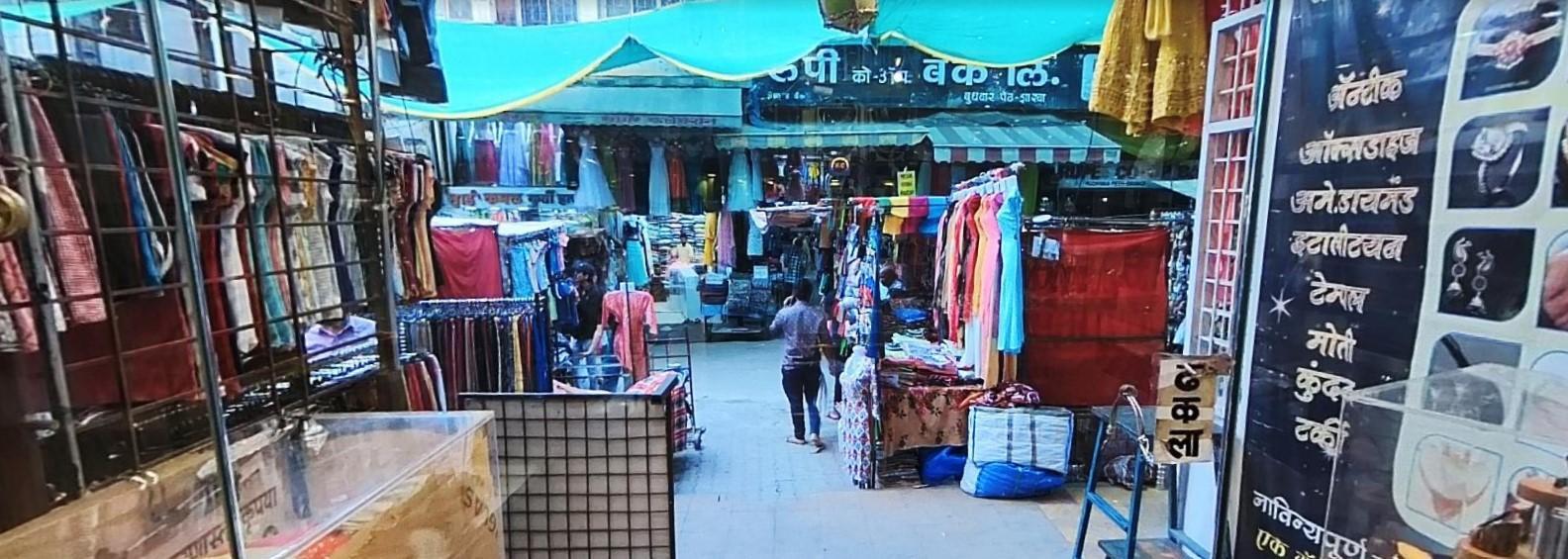
On the roads of the market one can find tattoo artists that use traditional mud moulds to stamp a particular design on the body. Such tattoo sellers are very common in the market. Apart from retail stores, there are also special food corners and shops like Karware Ice Cream, Shri Krishna Misal and Maharashtrian Bhojanalya. The Tulsi Baug Ganpati (Maanache Ganpati) is located in the vicinity and has a huge footfall during the Ganpati festival. The market is constantly crowded and the Ram mandir and the Ganpati are silent spectators to the changing face of Pune. This market remains closed on Mondays as do other markets in the area and locality.
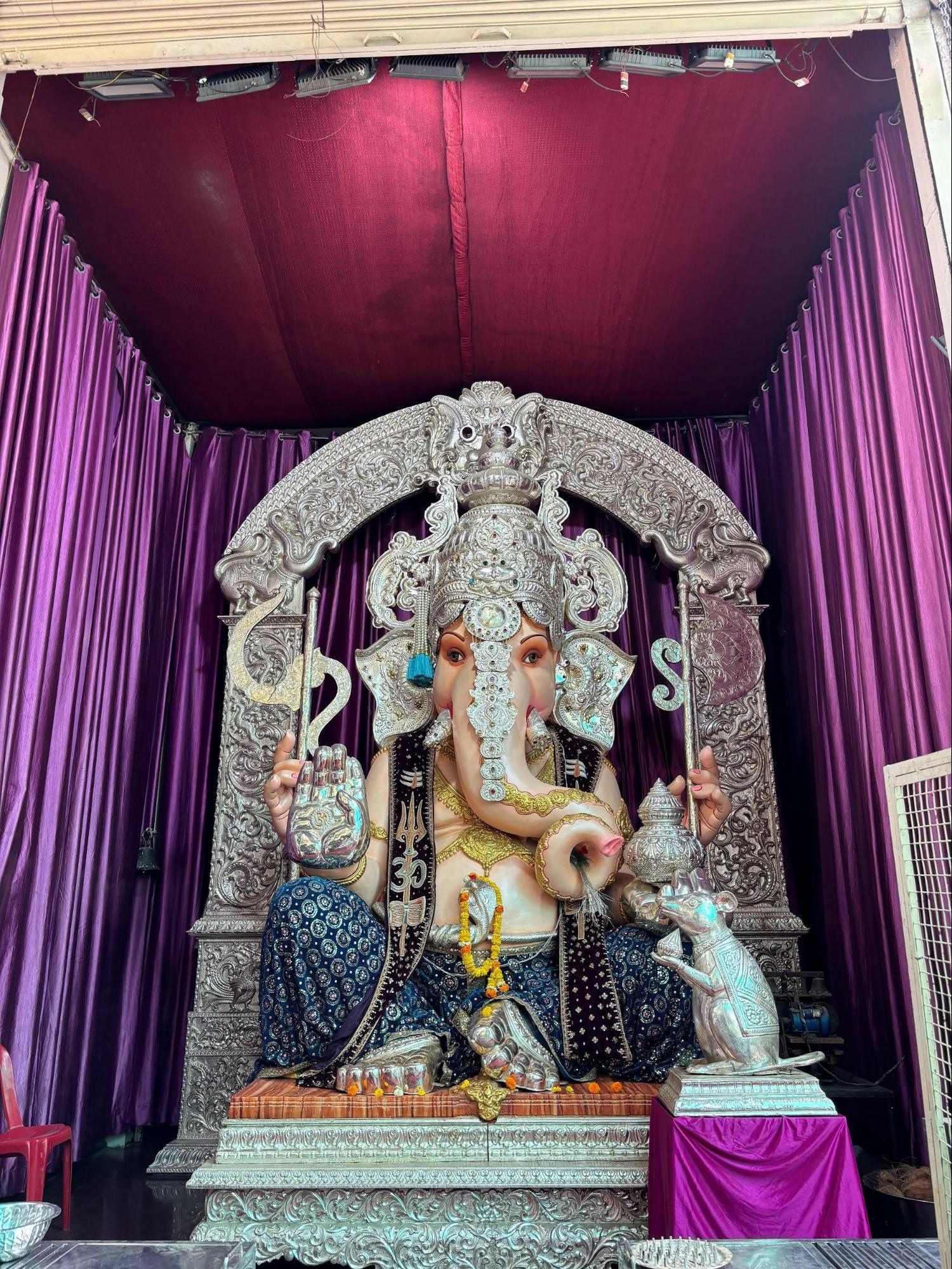
Its main features are a historic Mandir precinct and a large market. Tulshibaug gets its name from the Tulshibaug Wada located in this area, which is a famous Mandir of Bhagwan Ram, Ganpati and Shankar. The busy Tulsi Baug market is located in front of the famous Vishrambaug Wada. The market sells goods including traditional Maharashtrian cooking items, cosmetics, jewelry and household goods, as well as puja items. Other than shopping the market offers various refreshments and hotels.
Burud Ali
Burud Ali, or Bamboo Lane, is situated behind the Mahatma Phule Mandai. Well known for its bamboo artifacts, this market began to flourish in 1885. The bamboo sold here is imported from the Malwa region into Pune and Konkan region.
![Bamboo baskets and handmade products on display at Burud Ali, Pune’s last remaining traditional bamboo market.[4]](/media/culture/images/maharashtra/pune/markets/bamboo-baskets-and-handmade-products-on-display-_3ryb3cw.png)
According to locals, members of this community once made a bamboo basket for Devi Parvati to carry flowers in. Since then, they have pursued bamboo weaving as their profession. Ancestors of the Burud community have been living in Pune since the 17th century and during the Peshwa rule, every market in Pune used to have bamboo shops. However, only Burud Ali has survived with time. Every adult member of the family here is engaged in making bamboo artifacts, and they manufacture and sell everything from their home. Earlier, baskets, lanterns, chicken coops, and brooms were made. But with changing times, more modern objects, like curtains, lampshades, gunny carpets, and decorative objects, are being sold.
Cholkhan Ali
Cholkhan Ali is a historic market in Pune, estimated to be around 280 years old, and is best known for its signature khan cloth. The name "Cholkhan" is derived from the words choli (blouse) and khan, referring to the traditional blouse made from this distinctive fabric.
![Khan cloth blouses on display at Cholkhan Ali—where tradition meets contemporary style.[5]](/media/culture/images/maharashtra/pune/markets/khan-cloth-blouses-on-display-at-cholkhan-aliwhe_uAB1NLL.png)
Historically, khan cloth blouses were gifted by married women to female guests, and the material was primarily used in rural areas. Over time, however, khan fabric has made a comeback in urban fashion. Today, it is commonly used to make contemporary tops often paired with jeans, salwars, or styled traditionally. College students and young women especially wear khan blouses during cultural events or festive occasions, blending heritage with modern trends.
Narayangaon Tomato Market
Narayangaon in the district is a well known hub for tomatoes. Traders from not only neighboring cities and towns but also districts such as Gujarat and Karnataka come here in search of quality tomatoes. Regardless of the weather conditions, every morning at around eight, tempos arrive at the Bazar Samiti's gate, carrying tomatoes. Between 8:30 am and 9:30 am, traders enter the arena to participate in bidding. The price of each batch of tomatoes is determined based on quality, and the tempos then deliver the produce directly to the traders.
Gultekdi Phool Bazaar
The Gultekdi Phool Bazaar in Pune is a major wholesale flower market, established to meet international standards and streamline flower trading in the city. Known for its vibrant atmosphere and organized facilities, the market attracts both individual shoppers and large-scale traders.
![Colorful flower garlands and blooms on sale at Gultekdi Phool Bazaar, Pune’s central wholesale flower market.[6]](/media/culture/images/maharashtra/pune/markets/colorful-flower-garlands-and-blooms-on-sale-at-g_EjfwzJk.png)
A key feature of this bazaar is its digital auction hall, equipped with electronic clocks that display real-time pricing and availability, helping traders make informed purchasing decisions. The market offers a wide variety of flowers—from roses and marigolds (gendas) to seasonal and exotic blooms.
Visitors can find everything from loose flowers to garlands, wedding décor, pooja arrangements, and gift bouquets. With its fragrance, color, and constant bustle, Gultekdi Phool Bazaar remains an essential part of Pune’s floral economy.
Bohri Aali
Located in Raviwar Peth, Bohri Ali is a colorful and vibrant lane whose legacy dates back to the 18th century. The lane retains the city's old-world charm, fondly known as "Poona charm." But Bohri Ali is more than just a historical gem. It's a must visit place for DIY enthusiasts. The bustling lanes and by-lanes of this market offers everything from industrial paints to home decor, antiques, hardware supplies and much more. Some of the famous shops here include general hardware, bourbon trading corporation, AV garden tools and Kurban hussain Chandabhai.
Bhandi Aali
Bhandi Aali is Pune’s historic utensil trading lane nestled near Rameshwar Chowk and Mahatma Phule Mandai. Established over eight decades ago, this bustling market was once dominated by copper and brass—a legacy reflected in early trade. Today, however, stainless steel and ceramic utensils “rule the roost,” with stacks of pots, buckets, handis, and a wide range of kitchenware on offer.
The market’s transformation is evident in its evolution: aluminum was introduced around 30 years ago, and steel became the dominant material soon thereafter. Shoppers can find everything from gas burners, tava, and handi to mixers, dinner sets, and glassware. Some shops even sell items by weight, like plates at ₹200 per kilo, or offer name and date engraving at no extra cost. Several storeowners are descendants of families who began trading here 60+ years ago, and neighboring Nehru Chowk emerged later as a satellite utensil hub.
![Rows of gleaming steel and ceramic kitchenware on display at Bhandi Ali, Pune’s historic utensil lane.[7]](/media/culture/images/maharashtra/pune/markets/rows-of-gleaming-steel-and-ceramic-kitchenware-o_fZxY5Rh.png)
Ganesh Peth Fish Market
Out of all the fish markets in Pune, Ganesh Peth Fish Market is probably one of the cheapest places to buy fresh fish. The market only opens for 5 hours, i.e. from 6:00 am and closes around 11:00 am. It offers a wide variety of freshwater and saltwater fish at competitive prices. Other notable fish markets in the city include Chhatrapati Shivaji Market near Mandai, Simran Fish Market in Hadapsar, and Prakash Fish Market in Kothrud.
Last updated on 18 July 2025. Help us improve the information on this page by clicking on suggest edits or writing to us.